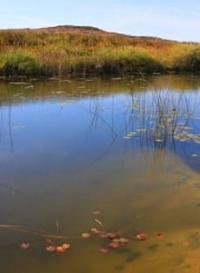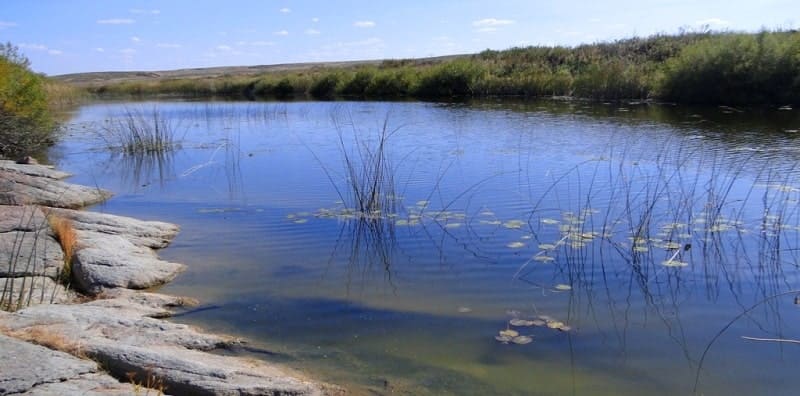You are here
Nura river in Kazakhstan.

Birding Tours to Karaganda region.
“On the morning of August 4, the expedition continued its journey near two lakes through which the Nura River flowed and stopped at the second of them to rest; at 3 o’clock in the afternoon a third lake was encountered, with up to 10 miles in circumference, and with it the ruins of an ancient city (Botakoz, according to G. Nabokov), stretching towards Nura.”
Diary of Ivan Shangin. Publication by the 8th grade bergmeister by the publisher G.I. Spassky. "Bulletin of Europe" in 1816.
Karaganda region nature.
Nura River is located at an altitude: at source 1098 meters above sea level, average flow is 529 meters above sea level and mouth into Lake Big Tengiz is 308 meters above sea level, river flows through territories of two regions of Karaganda and Akmola.
The source of the river is in the northern spurs of the Kyzylarai mountains on the northern slopes of the Kengaz mountains between the Khankashty mountains in the east and the Konyrkulzha mountains in the west. The Nura River (Kazakh Nura) is the largest river in the Nura-Sarysu basin.
The flow of the Nura River is directed into the internal basin located in the Tengiz-Korgalzhyn depression on the territory of the Korgalzhyn Nature Reserve - Lake Big Tengiz. In some high-water years, part of the Nura’s flow overflows into the Ishim River in the vicinity of the city of Astana through the rivers: Sarkyrama, Mukyr, Kozykosh and further into the Irtysh River.
The length of the river is 978 kilometers, the catchment area is 58.1 thousand square kilometers. It flows within the Kazakh small hills. The large steppe river Nura has year-round flow. Annual runoff volume is 466,000,000 meters. The water regime of the river has a pronounced spring flood and a long summer low-water period with extremely rare rain floods.
In spring, during the period of rapid floods, the river consumes up to 90% of its annual flow. The flood occurs at the end of March - beginning of April and lasts from 2 - 3 weeks to 1 - 2 months. The water level in the river can rise by 2 - 3 meters.
During the rest of the year, the river’s nutrition sharply decreases and occurs due to groundwater. Summer runoff is 3% of the annual runoff, autumn – 2%, winter – 7%. During the flood period, the river is desalinated and has bicarbonate-calcium water.
As the flow decreases, mineralization increases. During the low-water period, the water becomes sodium chloride. Once, in the floodplain of the Nura, a marsh turtle was encountered, the range of which is expanding to the north and east. The main tributaries of the Nura River are the rivers Sherubainura (right tributary), Ulkenkundyzdy, Ashchysu, Matak (right tributaries) and Akbastau.
Before the appearance of the Samarkand reservoir, up to 70% of the water went to Ishim through the Mukhor (Mukyr) and Sakroma (Sarkyrama) channels. The territory of the river basin belongs to areas of pronounced insufficient moisture. The peculiarity of the river is that the main volume of the annual flow (up to 90% and above) occurs during a short period of spring flood.
During summer-autumn-winter low water flows, river water flows are significantly reduced. In the summer it dries out in the upper reaches and freezes in the winter. The water in the lower reaches is brackish in summer. It freezes in early November and opens in April.
On the left bank of the river are the Alepaul mounds, a Bronze Age monument. In 1941, the Samarkand reservoir was built on the Nura River. The Irtysh - Karaganda canal crosses the Nura River along a siphon. The river is also crossed by the Nura - Ishim canal.
Intumak hydroelectric power station with a capacity of 0.6 MW on the Intumak reservoir through which the Nura River flows.
Geographic coordinates of Nura River: N50°05'31 E72°45'24
Geographic coordinates of sources of Nura River: N49°13'11 E74°46'06
Geographic coordinates of mouth of Nura River: N50°26'12 E69°14'00


Authority:
Alexander Petrov.
Brief Encyclopedia “Kazakh SSR”, Volume Two “Nature”. A.S. Beisenova, T.G. Smagulova.
Photos by:
Alexander Petrov.







